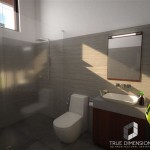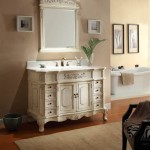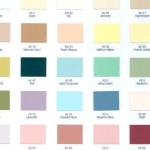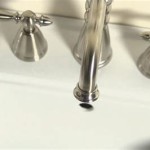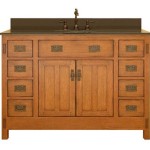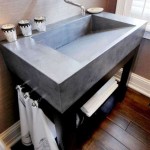How To Build A Bathroom Wall Shelf
Bathroom wall shelves provide valuable storage space in what is often the smallest room in the house. They offer a practical solution for organizing toiletries, towels, and decorative items, decluttering countertops and maximizing vertical space. Constructing a bathroom wall shelf is a manageable DIY project that can significantly enhance the functionality and aesthetics of the bathroom. Proper planning, material selection, and execution are crucial for a durable and visually appealing result.
This article outlines the step-by-step process for building a sturdy and attractive bathroom wall shelf. It covers everything from initial design considerations to installation techniques, ensuring a successful and rewarding home improvement endeavor. Emphasis will be placed on safety measures, accurate measurements, and secure mounting methods.
Planning and Design Considerations
Before commencing any construction, careful planning is essential. This stage involves determining the shelf's dimensions, style, and location, as well as considering the specific needs of the bathroom and the available space. A well-thought-out design will prevent errors and ensure the finished shelf effectively serves its purpose.
First, evaluate the available wall space. Measure the width, height, and depth of the intended shelf location. Consider any obstructions, such as plumbing pipes, electrical outlets, or light fixtures. The shelf's dimensions should be proportional to the bathroom size. A large, bulky shelf in a small bathroom will appear overwhelming, while a small shelf in a large bathroom may look insignificant.
Next, determine the shelf's intended use. Will it primarily hold lightweight items like soap and shampoo, or heavier items like towels and books? The weight-bearing capacity of the shelf will influence the choice of materials and the mounting method. For heavier items, select thicker shelves and more robust mounting hardware.
The shelf's style should complement the existing bathroom decor. Consider the color scheme, architectural style, and overall ambiance. Options range from simple, minimalist shelves made of plain wood to more elaborate designs with decorative brackets or painted finishes. Consider using materials that are resistant to moisture, such as treated wood or waterproof laminates.
Sketching the shelf design on paper is a helpful step. This allows for visualizing the finished product and making adjustments before cutting any materials. Include all dimensions and details, such as the number of shelves, the spacing between them, and the type of mounting hardware to be used.
Finally, consider accessibility. Ensure the shelf is positioned at a comfortable height for easy reach. Avoid placing it too high, which could make it difficult to access items on the top shelf. Similarly, avoid placing it too low, which could pose a tripping hazard or make it difficult to clean the floor beneath.
Materials and Tools
Selecting the appropriate materials and gathering the necessary tools is crucial for a successful shelf-building project. Choosing high-quality materials will ensure the shelf's durability and longevity. Having the right tools on hand will simplify the construction process and improve the accuracy of the cuts and joints.
For the shelf itself, several material options are available, including solid wood, plywood, MDF (medium-density fiberboard), and laminate. Solid wood offers a natural look and feel, but it can be more expensive and prone to warping or cracking in humid environments. Plywood is a more affordable and stable option, and it can be painted or stained to match the bathroom decor. MDF is a smooth, uniform material that is ideal for painting, but it is not as water-resistant as plywood. Laminate is a waterproof and durable option that is available in a wide variety of colors and patterns.
For the shelf supports, choose brackets that are strong enough to support the weight of the shelf and its contents. Options include metal brackets, wooden brackets, and floating shelf brackets. Metal brackets are typically the strongest and most durable option, while wooden brackets can add a decorative touch. Floating shelf brackets create a clean, minimalist look by hiding the supports.
The necessary tools will vary depending on the design and materials used. However, some essential tools include a measuring tape, pencil, level, saw (circular saw, jigsaw, or handsaw), drill, screwdriver, sandpaper, and safety glasses. A stud finder is also essential for locating wall studs for secure mounting.
Additional materials may include wood screws, drywall anchors, wood glue, paint or stain, and a sealant. Choose screws that are long enough to penetrate the wall studs or drywall anchors securely. Use wood glue to reinforce joints and ensure a strong bond. Apply paint or stain to protect the wood and enhance its appearance. Apply a sealant to protect the shelf from moisture and prevent water damage.
Prioritize safety by wearing safety glasses when cutting or drilling. Use a dust mask when sanding to prevent inhaling dust particles. Work in a well-ventilated area to avoid breathing in fumes from paint or sealant.
Construction and Installation
The construction and installation phase requires careful attention to detail and adherence to accurate measurements. This stage involves cutting the materials to size, assembling the shelf, and securely mounting it to the wall. Proper execution is essential for a stable and visually appealing finished product.
Begin by cutting the shelf boards to the desired length and width using a saw. Ensure the cuts are straight and accurate to avoid gaps or misalignments. Sand the edges of the boards to remove any splinters or rough spots. This will create a smooth surface for painting or staining.
Next, assemble the shelf using wood glue and screws. If using brackets, attach them to the underside of the shelf boards using screws. Ensure the brackets are evenly spaced and securely fastened. If building a floating shelf, follow the manufacturer's instructions for attaching the floating shelf brackets to the shelf boards.
Before mounting the shelf, locate the wall studs using a stud finder. Wall studs are vertical framing members that provide structural support for the wall. Mounting the shelf to the wall studs will ensure it is strong enough to support the weight of the shelf and its contents. Mark the locations of the wall studs on the wall.
Position the shelf against the wall at the desired height. Use a level to ensure the shelf is perfectly horizontal. Mark the locations of the mounting holes on the wall. Drill pilot holes through the wall at the marked locations. If mounting the shelf to drywall without studs, use drywall anchors to provide additional support. Insert the drywall anchors into the pilot holes.
Attach the shelf to the wall using screws. If mounting the shelf to wall studs, use screws that are long enough to penetrate the studs securely. If using drywall anchors, use screws that are compatible with the anchors. Tighten the screws until the shelf is firmly attached to the wall. Avoid overtightening the screws, which could strip the threads or damage the drywall.
Once the shelf is mounted, inspect it for stability and alignment. Ensure it is level and securely fastened to the wall. If necessary, make adjustments to the screws or brackets to correct any issues.
Finally, apply paint or stain to the shelf to protect the wood and enhance its appearance. Allow the paint or stain to dry completely before placing any items on the shelf. Apply a sealant to protect the shelf from moisture and prevent water damage. Clean up any debris or dust from the construction process.
Ensuring Durability and Longevity
To maximize the lifespan of the bathroom wall shelf, incorporating specific strategies focusing on moisture resistance, proper weight distribution, and regular maintenance is essential. Neglecting these aspects can lead to premature wear and tear, reducing the shelf's functionality and aesthetic appeal.
Moisture is a primary concern in bathrooms. To combat this, utilize water-resistant materials during construction. If solid wood is chosen, ensure it is properly sealed with a waterproof coating. Consider using teak or cedar, as they naturally repel moisture. For plywood or MDF, apply multiple coats of waterproof sealant to all surfaces, including edges and corners. Regular reapplication of sealant, especially in areas prone to water exposure, is recommended.
Proper weight distribution is crucial to prevent sagging or collapse. Avoid concentrating heavy items in one area of the shelf. Distribute the weight evenly across the entire surface. Reinforce the shelf with additional supports if it is intended to hold particularly heavy items. Staggering items on multiple shelves also helps distribute the load more uniformly.
Regular maintenance is paramount for preserving the shelf's condition. Wipe down the shelf regularly with a damp cloth to remove dust, soap scum, and water spots. Avoid using abrasive cleaners, which can damage the finish. For stubborn stains, use a mild detergent and a soft cloth. Inspect the shelf periodically for signs of water damage, such as discoloration, swelling, or mold growth. Address any issues promptly to prevent further damage.
Check the mounting hardware regularly to ensure it remains secure. Tighten any loose screws or replace damaged anchors. Periodically inspect the shelf for signs of warping or cracking. If any structural issues are detected, consult with a professional to determine the best course of action.
Alternative Shelf Designs and Mounting Techniques
While the aforementioned steps provide a general guideline, various alternative shelf designs and mounting techniques can be employed to suit individual preferences and bathroom layouts. Exploring these options allows for greater customization and can lead to a more aesthetically pleasing and functional result.
Floating shelves offer a sleek, minimalist look by concealing the support brackets. These shelves are typically mounted using specialized hardware that is embedded within the shelf itself. Installing floating shelves requires precise measurements and careful attention to detail, as the brackets must be perfectly aligned to ensure stability. Floating shelves are best suited for lighter loads, as they offer less weight-bearing capacity than traditional shelves with visible brackets.
Corner shelves are ideal for maximizing space in small bathrooms. These shelves are designed to fit snugly into corners, utilizing otherwise unused areas. Corner shelves can be mounted using brackets or by attaching them directly to the adjacent walls. When installing corner shelves, ensure the walls are square and plumb to avoid gaps or misalignments.
Tiered shelves offer multiple levels of storage in a compact footprint. These shelves can be built using a variety of materials and designs, from simple ladder-style shelves to more elaborate multi-tiered units. Tiered shelves are particularly useful for organizing toiletries, towels, and decorative items.
Recessed shelves, also known as niche shelves, are built into the wall itself. These shelves offer a clean, seamless look by eliminating the need for external brackets or supports. Installing recessed shelves requires opening up the wall cavity and framing the shelf opening. Recessed shelves are best suited for new construction or bathroom renovations, as they require significant structural modifications.
Ladder shelves provide a rustic and versatile storage solution. These shelves consist of a series of shelves mounted between two angled supports, resembling a ladder. Ladder shelves can be leaned against the wall or secured with brackets. They are easy to assemble and disassemble, making them a convenient option for renters or those who frequently relocate.

Diy Wall Shelves In The Bathroom Tutorial Bob Vila

Diy Floating Bathroom Shelves Shades Of Blue Interiors

How To Make A Hanging Bathroom Shelf For Only 10 Shanty 2 Chic

Apothecary Wall Shelf Free Diy Plans Rogue Engineer

Diy Built In Bathroom Shelves And Cabinet Angela Marie Made

Cottage Bathroom Storage Cabinet

4 Easy Steps To Make Diy Bathroom Shelves Rock Solid Rustic

How To Build A Diy Bathroom Floating Shelf Thediyplan

Diy Bathroom Cabinet Liz Marie Blog

Diy Bathroom Shelf The House Of Wood
Related Posts
